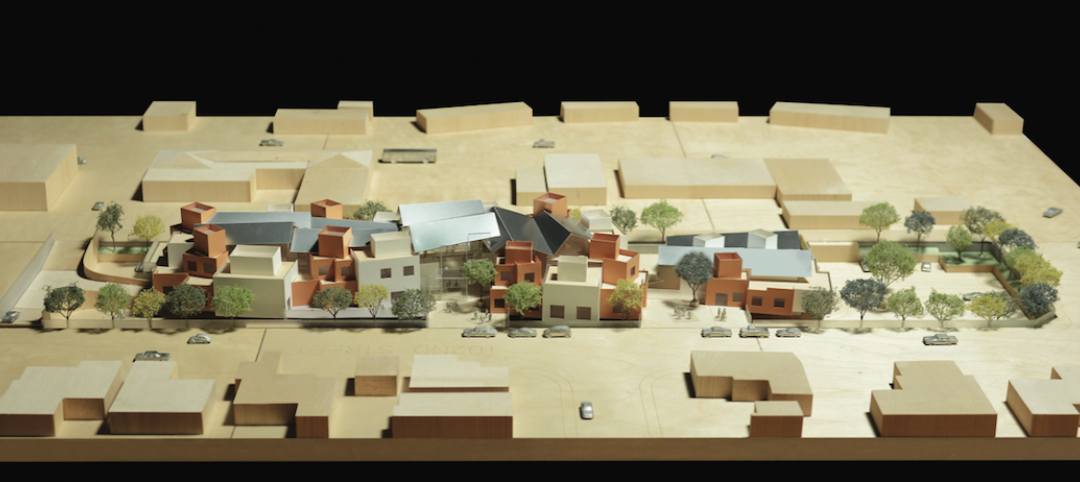The small, triangular speck of land — a brownfield site once occupied by a gas station — barely measured 7,500 sf and hardly seemed suitable for building much of anything, let alone a 49,700-sf academic and administrative center. However, its location in Boston's prestigious Longwood Medical Area, with an address on Huntington Avenue—known as the city's Avenue of the Arts —made it impossible for the Massachusetts College of Pharmacy and Health Sciences to pass up the unwieldy property. By early 2007, it was clear that the MCPHS's Boston campus was quickly outgrowing its current digs in the heart of the densely populated and land-scarce medical district. Hoping to build a modern new facility within walking distance of its main campus, MCPHS administrators jumped at the chance to develop the compact parcel.
Teaming with Perkins+Will for their fourth project together, MCPHS worked with the architects to create an infill plan that addressed the school's need for additional space. At the same time, the plan had to meet the concerns of the adjacent residential community — the Mission Hill Triangle Historic District, an old neighborhood full of Victorian brownstones and single-family homes and active, vocal residents. Huntington Avenue serves as the boundary between the two, with the Richard E. Griffin Academic Center at ground zero and forced to meet the needs of two very different communities.
The Mission Hill community had long been wary of new development encroaching on their neighborhood, and they'd been burned by urban renewal efforts in the past, including construction of public housing apartment towers — some 20 stories tall — in the middle of their neighborhood. Taking their concerns to heart, MCPHS made the neighbors part of the Building Team and invited them (and other stakeholders) to regular design meetings.
Gerald Autler, senior project manager and planner with the Boston Redevelopment Authority, credits the school's decision to include its neighbors early in the planning process with diffusing what could have been a contentious situation. Autler points to the Building Team's request for additional height as something that "could have been an explosive issue." Instead, with the community a part of the decision-making process, the bid for extra height won their support. "The process went as smoothly as any I have ever been involved in," says Autler.
Even with the extra height, the building still rises only six stories above ground (with two additional below-ground levels) and matches the scale of its residential neighbors. A brick facade adds a traditional Bostonian touch, while abundant glazing and a glass street-level lobby inject contemporary elements expected of an urban, modern educational facility focused on the health sciences. The Perkins+Will designers also made sure to mask the service and equipment acess on the side of the building facing the neighborhood, to minimize any perception of that facade as being the"service area."
A Revit BIM model aided the project's fast-track design and construction schedule and allowed the Building Team, including general contractor Bond Brothers, Inc., to simultaneously produce renderings and construction documents for concurrent city and client approval and to issue early bid packages for earthwork, concrete foundations, steel, and mechanical systems in timely fashion. To remediate the brownfield site (which also abuts a transit line), most of the soil had to be abated on site and trucked away because there was no place to store excavated materials. With minimal staging and laydown space, delivery and storage of materials was another nightmare. The Building Team utilized sidewalks and just-in-time delivery and worked closely with the Boston Transportation Department to coordinate deliveries.
Despite the tight squeeze, a nearly fifty-thousand-square-foot facility was successfully shoehorned into the remnant property, housing the college's School of Nursing, School of Physician Assistant Studies, Office of Institutional Advancement, and Office of College Relations. The six-story center contains a technology center, student commons, classrooms, patient assessment and clinical simulation teaching labs, and faculty offices.
A 230-seat auditorium — which required a 30-foot-deep excavation — sits below-grade, while a multifunction conference space (which is available for use by the community) occupies the top floor and offers unobstructed views of the Boston skyline.
In honoring the Richard E. Griffin Academic Center with a Silver Award, the jury members were impressed with the Building Team's community outreach and its ability to overcome unusually difficult site constraints.
PROJECT SUMMARY
Silver Award
The Richard E. Griffin Academic Center,
Massachusetts College of Pharmacy and Health Sciences
Boston, Mass.
Building Team
Submitting firm: Perkins+Will (architect)
Owner: Massachusetts College of Pharmacy and Health Sciences
Interior designer: Kristine Stoller Interior Design
Structural engineer: Souza True Partners
MEP engineer: RDK Engineers
General contractor: Bond Brothers, Inc.
General Information
Project size: 49,700 sf
Construction cost: Confidential, at client’s request
Construction time: August 2007 to January 2009
Delivery method: CM at risk
Related Stories
Market Data | Jan 20, 2016
Nonresidential building starts sag in 2015
CDM Research finds only a few positive signs among the leading sectors.
Architects | Jan 15, 2016
Best in Architecture: 18 projects named AIA Institute Honor Award winners
Morphosis' Perot Museum and Studio Gang's WMS Boathouse are among the projects to win AIA's highest honor for architecture.
| Jan 14, 2016
How to succeed with EIFS: exterior insulation and finish systems
This AIA CES Discovery course discusses the six elements of an EIFS wall assembly; common EIFS failures and how to prevent them; and EIFS and sustainability.
University Buildings | Sep 21, 2015
6 lessons in campus planning
For campus planning, focus typically falls on repairing the bricks and mortar without consideration of program priorities. Gensler's Pamela Delphenich offers helpful tips and advice.
Designers | Sep 21, 2015
Can STEAM power the disruptive change needed in education?
Companies need entrepreneurial and creative workers that possess critical thinking skills that allow them to function in collaborative teams. STEAM (science, technology, engineering, arts, and mathematics) education might be the solution.
Education Facilities | Sep 14, 2015
Gehry unveils plan for Children's Institute, Inc. campus in LA
The new facility, which will have rooms for counseling, afterschool activities, and youth programs, will allow CII to expand its services to 5,000 local children and families.
Education Facilities | Sep 2, 2015
Mock neighborhood simulates ‘real’ driving conditions for automated vehicles
The University of Michigan’s Mcity is a public-private partnership interested in overcoming unpredictable obstacles to driverless travel.
Mixed-Use | Aug 26, 2015
Innovation districts + tech clusters: How the ‘open innovation’ era is revitalizing urban cores
In the race for highly coveted tech companies and startups, cities, institutions, and developers are teaming to form innovation hot pockets.
University Buildings | Aug 13, 2015
Best of Education Design: 9 projects named AIA Education Facility Design Award winners
Georgia Tech's Clough Commons, Boston's Berklee Tower, and seven other facilities were honored for aiding learning and demonstrating excellent architectural design.
Giants 400 | Aug 7, 2015
K-12 SCHOOL SECTOR GIANTS: To succeed, school design must replicate real-world environments
Whether new or reconstructed, schools must meet new demands that emanate from the real world and rapidly adapt to different instructional and learning modes, according to BD+C's 2015 Giants 300 report.
















